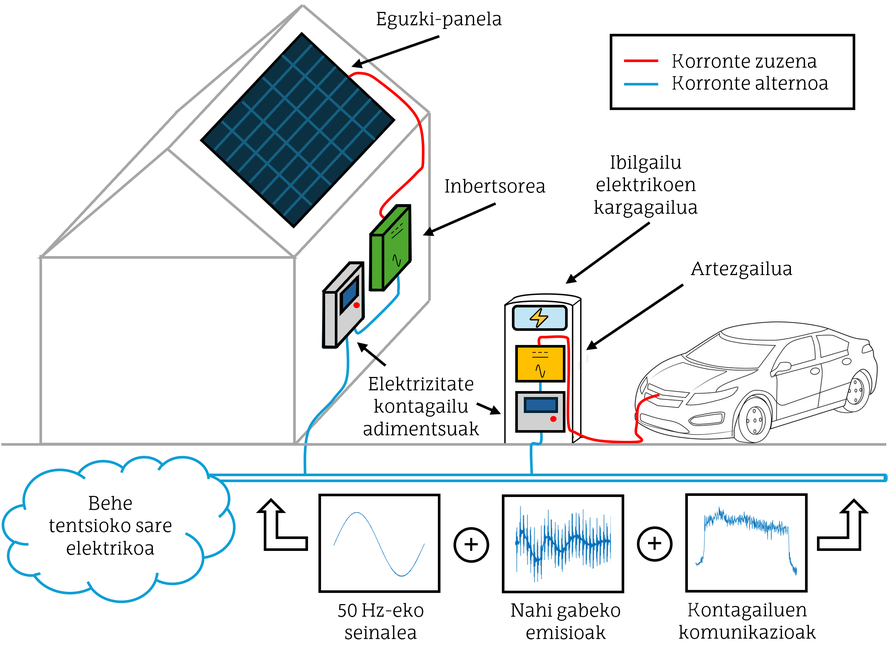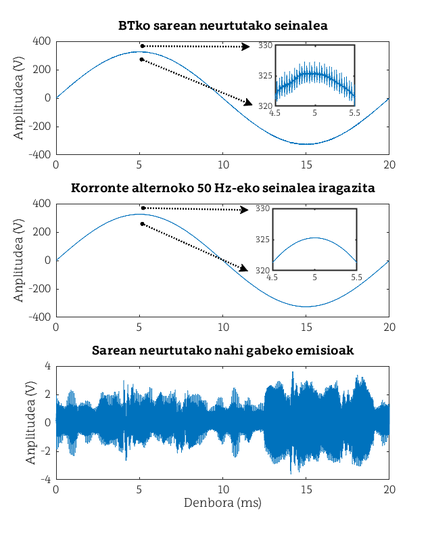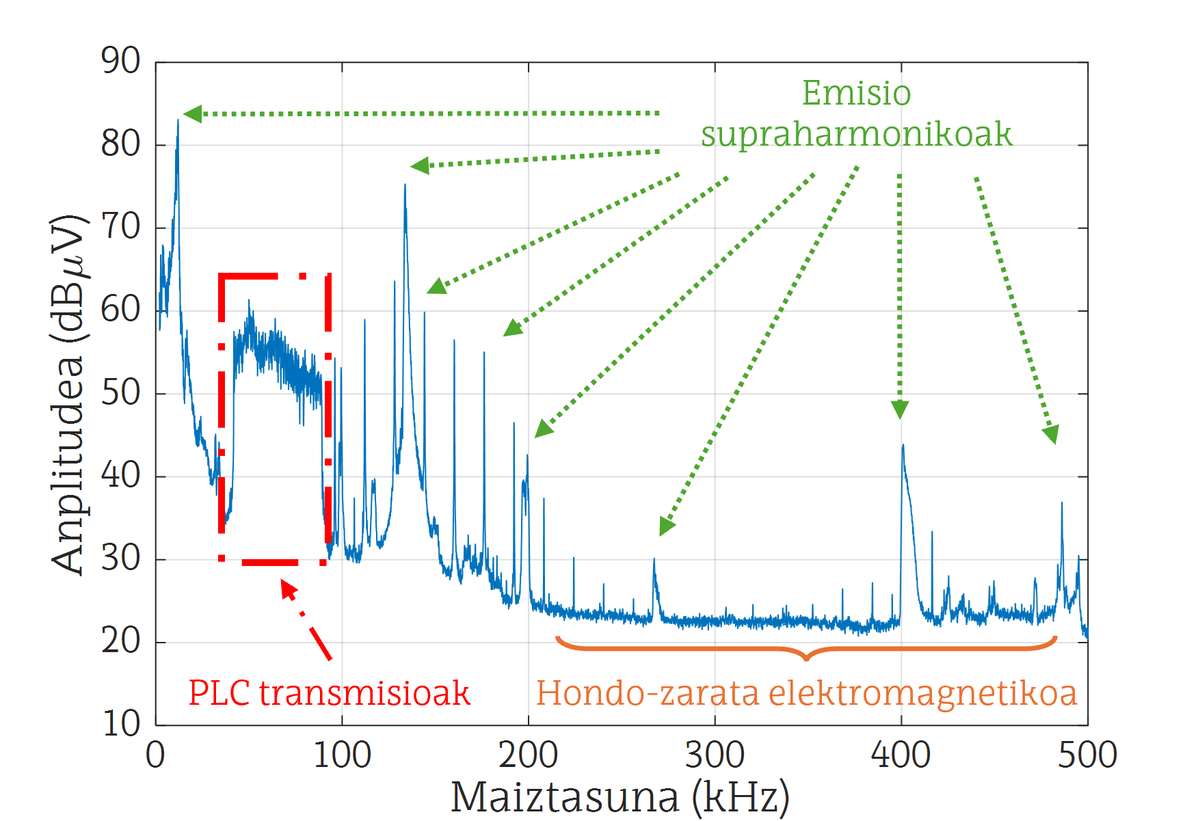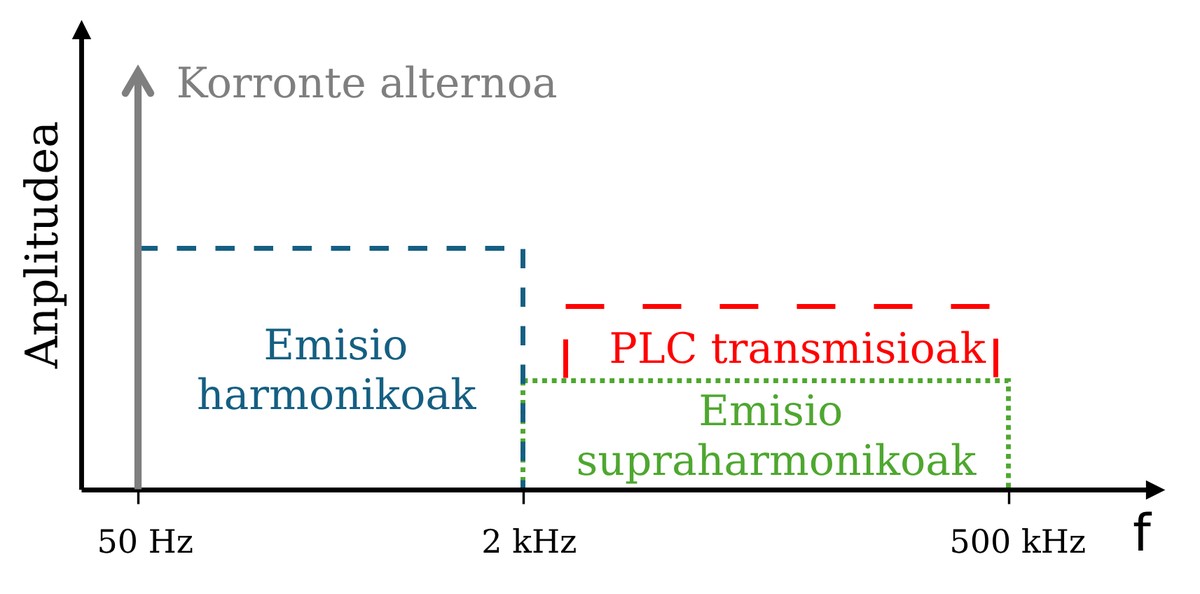“Supraharmonic” emissions: invisible members of electricity from renewable sources
In the next decade, having solar panels and electric vehicle chargers on all of our streets and homes will be a normal thing. However, did you know that such devices inject “supraharmonic” emission signals into power networks? In recent years, supraharmonic emissions have taken the attention of power companies and the research community, as the combination of emissions generated by many devices can cause harmful effects on electricity networks and devices connected to them.

One of the main objectives of the 2015 Paris Climate Agreement, promoted by the United Nations, is to achieve a carbon neutral economy. This climate agreement sets a number of long-term goals for all nations. Among these measures is the reduction of greenhouse gas emissions, limiting this century's temperature increase to 2 °C worldwide. The European Union has established in its legal framework the commitments agreed in the Paris Climate Agreement, through the European Green Climate Pact 2019 and the European Climate Act 2021. These agreements state that carbon emissions in 2030 should be 55% lower than measures in 1990. Electromobility or e-mobility and distributed generation of renewable energy will be key to reducing social dependence on fossil fuels.
The policies of the United Nations and the European Union have begun to affect the daily lives of the population. Chargers and solar panels of electric vehicles are being installed massively in homes and streets connected to the low voltage network. In addition, an exponential increase of this type of devices in the low voltage network is expected in the future.

The influence of electric vehicle loaders and solar panels on the low voltage network has been studied in recent decades. They have rectifiers and investors to change the characteristics of electricity. Rectifiers capture alternating current (50 Hz power signal) and convert it into DC. Electric vehicle chargers are used to transform electricity from the low-voltage grid, as electric vehicle batteries work in DC. Conversely, investors convert DC into AC. These devices are used in the case of solar panels, as the electricity generated by solar panels is in the form of direct current and the low voltage network works in alternating current. These versions of electricity generate impurities due to the electronic techniques and components implemented by investors and rectifiers. These impurities are injected as unwanted signals or emissions into low-voltage alternating current networks that propagate in the network with a 50 Hz signal. The discipline in charge of studying these impurities is called “quality of potency”, derived from the English term “power-quality”.
Power quality is measured from the creation of power networks and frequency components that appear outside the 50 Hz power signal are characterized. Numerous studies have been published in the literature analyzing the phenomena of interference in low voltage networks (less than 2 kHz). Unwanted emissions occur at low frequencies because they are “harmonic”. These are 50 Hz signal impurities and are found in multiples of alternating current frequency (50 Hz), such as 100 Hz (first harmonic), 150 Hz (second harmonic), 200 Hz (third harmonic), etc. However, unwanted emissions occur at frequencies above harmonic 40 (2 kHz). From this frequency, unwanted emissions are not harmonic for the 50 Hz power signal, but depend on switching frequencies of techniques and components implemented by inverters and rectifiers. Unwanted emissions generated by such equipment are usually in the frequency range from 2 kHz to 500 kHz.
“Supraharmonic” emissions are known as unwanted frequency components which can be measured in the frequency range from 2 kHz to 500 kHz. The word supraharmonic is used to designate emissions occurring at frequencies above 2 kHz because the term supraharmonic is a combination of the Latin words “supra” and English words “harmonic” above harmonic ones. The term supraharmonic, widely used in the research community, can cause a poor understanding of the physical phenomenon of unwanted emissions occurring between 2 kHz and 500 kHz. The source of these unwanted emissions is not related to AC impurities, but to the working frequencies of components and rectifier and inverter techniques.
Within the frequency range of supraharmonic emissions, power line communications (PLC) transmissions occur in the 10-490 kHz band. PLC technologies use power grid cables as a means of communication. Currently, PLC technologies are the main communication systems of “smart” meters that measure electricity consumption and generation in homes and companies, through which telemetry information of electricity consumption is transmitted to the managing companies of low voltage networks. Thanks to PLC technologies, electricity companies have developed tariffs with variable prices throughout the day that can depend on the demand and supply of the electricity market.
Supraharmonic emissions can produce unwanted effects or have a negative impact on low voltage networks and devices connected to them. These unwanted emissions, if their amplitude level is too high, may jeopardise the proper functioning of some devices. On the other hand, the energy of supraharmonic emissions has been linked to the “thermal stress” suffered by the devices, which reduces the service life of the electronic components that implement the equipment, which accelerates their aging. In addition, PLC communications are transmitted at frequencies where supraharmonic emissions are propagated, so unwanted emissions can interfere with PLC transmissions and charge communications transporting telemetry information. Although the negative effects described have a small percentage of equipment connected to the low voltage network, when millions of smart devices and meters are connected to the network, it is necessary to take measures to mitigate these effects.

The negative effects of supraharmonic emissions have generated many research possibilities for the design of new techniques and/or devices that prevent the impact of these emissions. Research carried out in recent years has led to the launch of commercial filters that weaken the supraharmonic emissions generated by appliances. In addition, the limits of signal amplitude that devices can inject into the network have been defined in international standards that equipment manufacturers should consider when designing devices. Furthermore, the maximum level that can be reached by combinations of all supraharmonic emissions generated by all devices on the network and that must be controlled by electricity companies operating low voltage networks has been established. On the other hand, eleven techniques based on signal processing have been published for PLC communication to work at 100%. The aim of these techniques is to eliminate the interference phenomena produced by supraharmonic emissions in PLC transmissions or at least to reduce their impact. However, there are still many studies on these emissions from the metrological point of view (science that studies the accuracy of measures), related to improving the speed and coverage of PLC communications.
The research group TSR (Signal Processing and Radiocommunication) of the School of Engineering of Bilbao of the University of the Basque Country (UPV/EHU), after studying the quality of television and radio signals since 1998, created a new research line 9 years ago called “Communications for Smart Power Networks”. This line of research aimed to guide research possibilities around supraharmonic emissions and meet the demands of companies in the Basque Country.
In the research group TSR of the UPV/EHU, a series of own meters have been created to characterize the electrical network in the frequency range of supraharmonic frequencies. Generated instruments include supraharmonic emission meters in a frequency range from 9 kHz to 20 MHz, from which probes of such meters have been defined to real-time measurement processing codes. In addition, measurement instruments have been created to measure the input impedance presented by the low voltage network in the same frequency range and to quantify the weakening of the PLC communication signals between the two network points. These devices provide the data needed to fully characterize the low voltage network. These data have been used to characterize the interference mechanisms that low voltage networks generate in PLC technology communications. However, interference in PLC communications has been characterized by both laboratory tests and tests on low voltage networks. Likewise, the data collected in low voltage networks have been used to analyze the metrology of the measurements by means of uncertainty studies of the techniques implemented by the instruments that measure the power quality defined in international standards and which can be found in the market.
Moreover, the research carried out in the research group TSR of the UPV/EHU has served to make contributions of great international impact on standardization and research. Contributions include participation in the European EMPIR-SupraEMI project, funded by EURAMET (Association of National Metrology Centres), as well as contributions made in different working groups of IEC (International Electrotechnical Committee) and CENELEC (European Commission for Electrotechnical Standardisation) organisations responsible for setting international standards.
In short, in the coming decades, the number of solar panels and chargers of electric vehicles connected to low voltage networks will increase exponentially due to the decarbonisation policies of the United Nations and the European Union. These devices generate and inject superharmonic emissions into low-voltage networks and can negatively affect other equipment. However, several studies on the prevention and mitigation of supraharmonic emissions have been carried out or are under way. Conclusions from these studies will be very useful to ensure a good power quality of low voltage networks when in the future the number of solar panels and chargers of electric vehicles is considerable.
Acknowledgments:
This work has been financed by the Basque Government through grants IT1436-22, PRE_2023_2_0037 and PRE_2023_2_0162. This work has also been funded by PID2021-124706OB-I00, MCIN/AEI/10.13039/501100011033 and the European Regional Development Fund: A way to make Europe.
Bibliography:
- https://unfccc.int/process-and-meetings/the-paris-agreement
- https://commission.europa.eu/strategy-and-policy/priorities-2019-2024/european-green-deal_en
- Alexander Gallarreta, Jon González-Ramos, Stefano Lodetti, Peter Davis, Igor Fernández, David de la Vega, Itziar Angulo, Amaia Arrinda. In the review process. “Measurement framework for the consistent and fast measurement of conducted grid emissions in the 9 500 kHz range”. Computers and Electrical Engineering.
- Angela Espín-Delgado, Sarah Rönnberg, Shimi Sudha Letha, Math Bollen. 2021. "Diagnosis of supraharmonics related problems based on the effects on electrical equipment". Electric Power Systems Research. 195. DOI: 10.1016/j.epsr.2021.107179.
- R. H. Anders Larsson; Math H. J. Bollen; Mats G. Wahlberg; C. Martin Lundmark; Sarah K. Rönnberg. 2010. "Measurements of High-Frequency (2–150 kHz) Distortion in Low-Voltage Networks". IEEE Transactions on Power Delivery, 25. DOI: 10.1109/TPWRD.2010.2041371.
- Igor Fernández, Alexander Gallarreta, Jon González-Ramos, Paul Wright, David de la Vega, Itziar Angulo, Amaia Arrinda. 2023. “Measurement System of the Mean and Sub-cycle LV Grid Access Hosted from 20 kHz to 10 MHz”. IEEE Transactions on Power Delivery. 38. DOI: 10.1109/TPWRD.2023.3238647
- Jon González-Ramos, Alexander Gallarreta, Igor Fernández, Itziar Angulo, David de la Vega, Amaia Arrinda. 2024. “Comparison of conducted emissions due to electric vehicle charging processes under isolated and on-line conditions in the 9–500 kHz frequency range”. Sustainable Energy, Grids and Networks. 36. DOI: 10.1016/j.segan.2024.101333.
- Jon González-Ramos, Alexander Gallarreta, Itziar Angulo, Igor Fernández, Amaia Arrinda, David de la Vega. 2023. “A review on the empirical characterization of the low voltage distribution grid as a communication channel for power line communications”, Sustainable Energy, Grids and Networks. 36. DOI: 10.1016/j.segan.2023.101217.
- Tim Slangen, Vladimir VOCCuk. 2023. "Summation of supraharmonic currents (2–150 kHz) from EV fast charging stations", Electric Power Systems Research, 220. DOI: 10.1016/j.epsr.2023.109371.
- Vineetha Ravindran, Selcuk Sakar, Sarah Rönnberg, Math H.J. Bollen. 2020. Characterization of the impact of PV and EV induced voltage variations on LED lamps in a low voltage installation. Electric Power Systems Research. 185. DOI: 10.1016/j.epsr.2020.106352.






